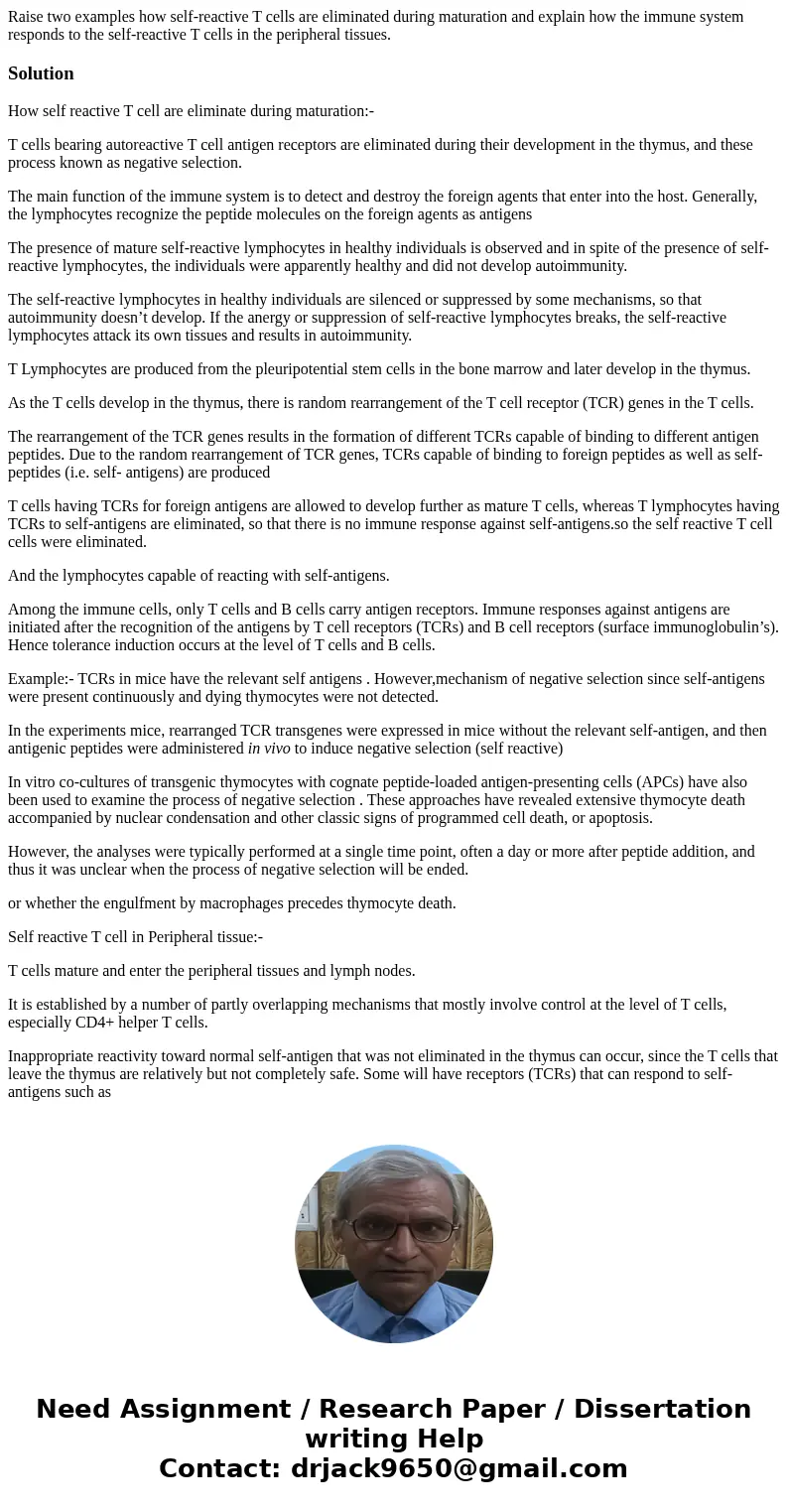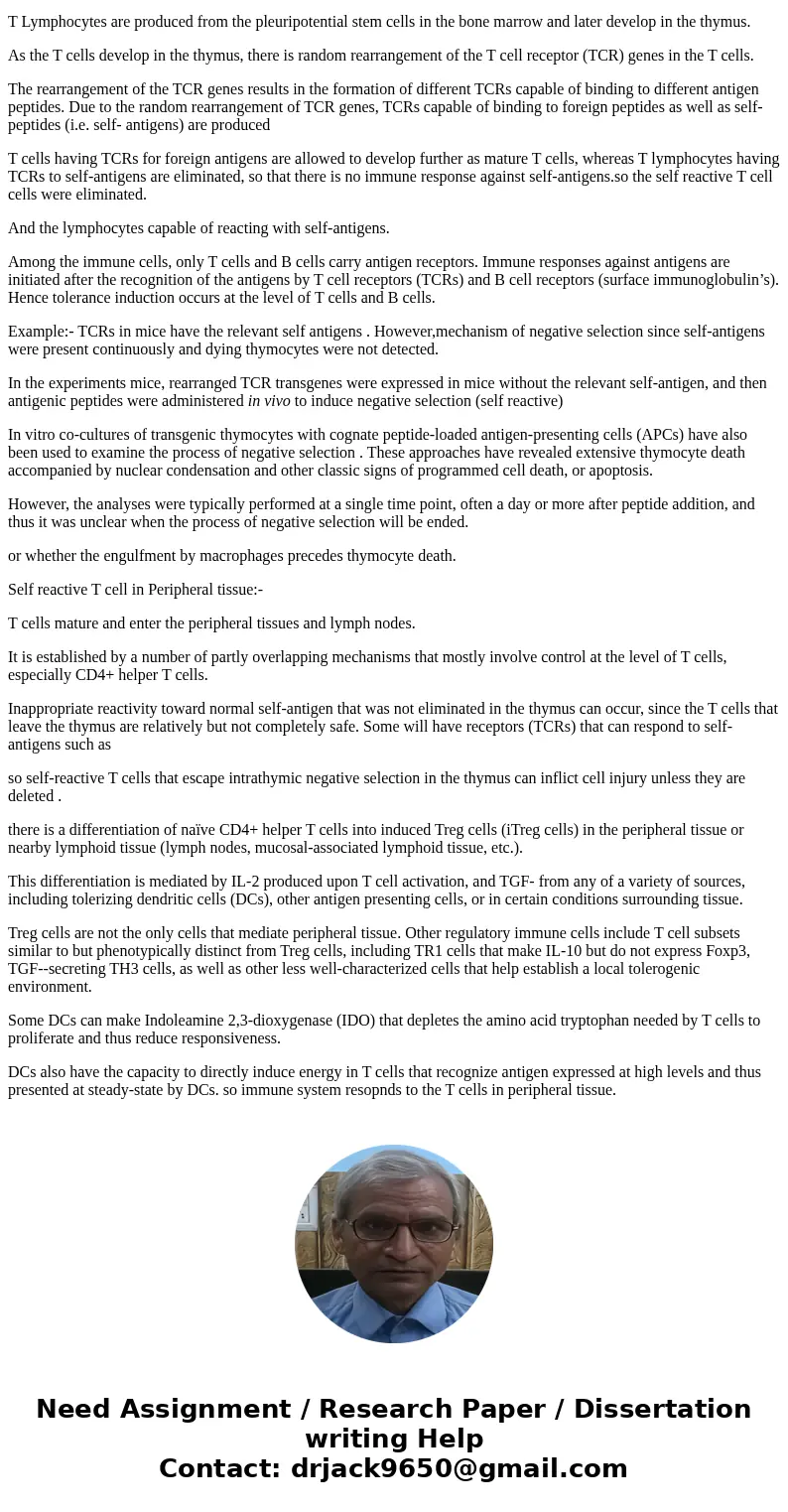Raise two examples how selfreactive T cells are eliminated d
Raise two examples how self-reactive T cells are eliminated during maturation and explain how the immune system responds to the self-reactive T cells in the peripheral tissues.
Solution
How self reactive T cell are eliminate during maturation:-
T cells bearing autoreactive T cell antigen receptors are eliminated during their development in the thymus, and these process known as negative selection.
The main function of the immune system is to detect and destroy the foreign agents that enter into the host. Generally, the lymphocytes recognize the peptide molecules on the foreign agents as antigens
The presence of mature self-reactive lymphocytes in healthy individuals is observed and in spite of the presence of self-reactive lymphocytes, the individuals were apparently healthy and did not develop autoimmunity.
The self-reactive lymphocytes in healthy individuals are silenced or suppressed by some mechanisms, so that autoimmunity doesn’t develop. If the anergy or suppression of self-reactive lymphocytes breaks, the self-reactive lymphocytes attack its own tissues and results in autoimmunity.
T Lymphocytes are produced from the pleuripotential stem cells in the bone marrow and later develop in the thymus.
As the T cells develop in the thymus, there is random rearrangement of the T cell receptor (TCR) genes in the T cells.
The rearrangement of the TCR genes results in the formation of different TCRs capable of binding to different antigen peptides. Due to the random rearrangement of TCR genes, TCRs capable of binding to foreign peptides as well as self-peptides (i.e. self- antigens) are produced
T cells having TCRs for foreign antigens are allowed to develop further as mature T cells, whereas T lymphocytes having TCRs to self-antigens are eliminated, so that there is no immune response against self-antigens.so the self reactive T cell cells were eliminated.
And the lymphocytes capable of reacting with self-antigens.
Among the immune cells, only T cells and B cells carry antigen receptors. Immune responses against antigens are initiated after the recognition of the antigens by T cell receptors (TCRs) and B cell receptors (surface immunoglobulin’s). Hence tolerance induction occurs at the level of T cells and B cells.
Example:- TCRs in mice have the relevant self antigens . However,mechanism of negative selection since self-antigens were present continuously and dying thymocytes were not detected.
In the experiments mice, rearranged TCR transgenes were expressed in mice without the relevant self-antigen, and then antigenic peptides were administered in vivo to induce negative selection (self reactive)
In vitro co-cultures of transgenic thymocytes with cognate peptide-loaded antigen-presenting cells (APCs) have also been used to examine the process of negative selection . These approaches have revealed extensive thymocyte death accompanied by nuclear condensation and other classic signs of programmed cell death, or apoptosis.
However, the analyses were typically performed at a single time point, often a day or more after peptide addition, and thus it was unclear when the process of negative selection will be ended.
or whether the engulfment by macrophages precedes thymocyte death.
Self reactive T cell in Peripheral tissue:-
T cells mature and enter the peripheral tissues and lymph nodes.
It is established by a number of partly overlapping mechanisms that mostly involve control at the level of T cells, especially CD4+ helper T cells.
Inappropriate reactivity toward normal self-antigen that was not eliminated in the thymus can occur, since the T cells that leave the thymus are relatively but not completely safe. Some will have receptors (TCRs) that can respond to self-antigens such as
so self-reactive T cells that escape intrathymic negative selection in the thymus can inflict cell injury unless they are deleted .
there is a differentiation of naïve CD4+ helper T cells into induced Treg cells (iTreg cells) in the peripheral tissue or nearby lymphoid tissue (lymph nodes, mucosal-associated lymphoid tissue, etc.).
This differentiation is mediated by IL-2 produced upon T cell activation, and TGF- from any of a variety of sources, including tolerizing dendritic cells (DCs), other antigen presenting cells, or in certain conditions surrounding tissue.
Treg cells are not the only cells that mediate peripheral tissue. Other regulatory immune cells include T cell subsets similar to but phenotypically distinct from Treg cells, including TR1 cells that make IL-10 but do not express Foxp3, TGF--secreting TH3 cells, as well as other less well-characterized cells that help establish a local tolerogenic environment.
Some DCs can make Indoleamine 2,3-dioxygenase (IDO) that depletes the amino acid tryptophan needed by T cells to proliferate and thus reduce responsiveness.
DCs also have the capacity to directly induce energy in T cells that recognize antigen expressed at high levels and thus presented at steady-state by DCs. so immune system resopnds to the T cells in peripheral tissue.


 Homework Sourse
Homework Sourse